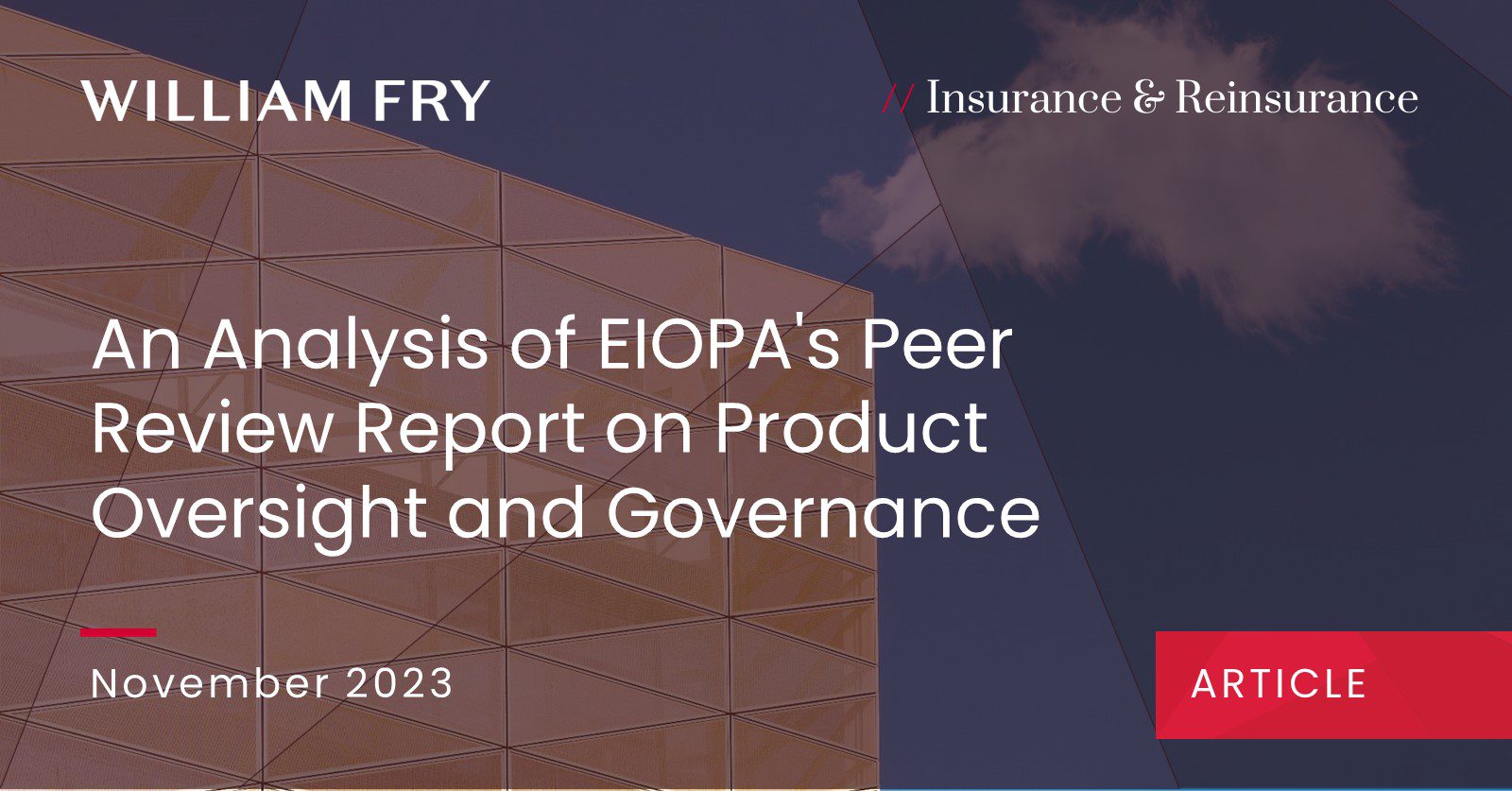The European Insurance and Occupational Pensions Authority (EIOPA), with the support of National Competent Authorities (NCAs) in the EEA, recently conducted a peer review (Peer Review) on requirements for product oversight and governance (POG), introduced by the Insurance Distribution Directive (IDD).
The Peer Review assessed the overall maturity of the supervisory framework on POG developed by NCAs to supervise the application of POG requirements by insurance manufacturers. The review period spanned 1 October 2018 to 31 March 2022. The supervisory expectations were grouped into the following areas:
- Organisation and resources of POG supervision;
- Risk-based approach;
- Setting and communicating supervisory expectations;
- Supervisory methodologies and tools;
- Supervisory activities.
The reason behind the Peer Review
Supervision of POG enables NCAs to understand and assess the processes underpinning products manufactured and distributed by insurance undertakings to mitigate the risk of these products not meeting consumers’ interests. Given the importance of effective supervision of POG, it is necessary for EIOPA to thoroughly scrutinise the NCAs’ approach to such supervision.
Methodology and approach
The basis of the Peer Review was a self-assessment questionnaire followed by fieldwork to clarify the responses to the questionnaire. In relation to the latter, the Central Bank of Ireland (CBI) was subject to a virtual visit by investigators. EIOPA’s report (Report) summarises the findings of the Peer Review and the recommended actions addressed to NCAs.
The CBI’s performance and recommended action
From an Irish perspective, the CBI was described as an NCA, which incorporated POG into its supervisory approach. It achieved this by prioritising POG supervision within the conduct of business supervision, as reflected in its supervisory strategic plans and operational plans; integrating POG supervision in the internal processes and procedures; embedding POG supervision in its ongoing supervisory activities; and allocating experienced resources to POG supervision.
Further, the CBI was identified as an NCA that has introduced POG elements in its risk-based framework encompassing both product-specific and undertaking-specific risk assessment. In this respect, EIOPA observed that the use of quantitative indicators accompanied by qualitative analyses led to the identification of the main risks for consumers and the prioritisation of supervisory activities and different supervisory actions.
Moreover, the Report notes that the CBI was one of the NCAs which had carried out deep dives, follow-up actions and market-wide and undertaking-specific assessments in its supervision of manufacturers’ implementation of POG arrangements.
Overall, in its categorisation of NCAs according to the extent to which they are meeting expectations, the CBI was classified as “broadly meeting expectations” having been issued with just one recommended action. Under this recommended action, the CBI must formulate and communicate to the market a comprehensive set of supervisory expectations covering all the elements of POG requirements applied to Insurance-Based Investment Products (IBIPs). Such communication should be funnelled through guidelines, letters to the market, circulars, publications, or supervisory dialogues to clearly establish how POG requirements should be applied in day-to-day business. Life insurers can expect increased intervention from the CBI in respect of POG requirements they apply to IBIPs, as the CBI will be considerably more active and probing in its governance of this space.
This recommended action is designed to ensure that manufacturers have a clear understanding of the supervisory expectations for customer-centric POG arrangements. A clear communication strategy by NCAs must ensure these expectations are sufficiently known by the relevant stakeholders to foster market discipline. For more complex products with a higher risk of consumer detriment, more rigorous supervisory expectations should be formulated, leading to more demanding POG measures.
The CBI is advised to follow up by challenging the effectiveness of POG arrangements by supervised entities based on these expectations.
Holistic findings
The main findings of the Report can be summarised as follows:
- A few NCAs have adapted their internal processes to include the supervision of POG requirements in a manner which EIOPA considers to be sufficient for achieving the outcome sought by POG.
- Some NCAs were in the process of improving their supervisory POG framework to ensure good consumer outcomes for complex life products during the review period, while some were still in the process of building their supervisory POG framework.
- There were significant differences between NCAs as to the level of maturity of POG supervision.
- In several jurisdictions, NCAs plan, or have started, to review their approach to POG supervision. They seek to improve it by embedding POG into their mid-term strategies in line with EIOPA Union-wide Strategic Supervisory Priorities, adapting internal processes and integrating their supervisory work plans with an increase in dedicated supervisory activities on POG.
- In some cases, material developments were already implemented and observed between the end of the reference period and the date of development of this report (i.e. outside the reference period of the Peer Review). These will be further assessed during the follow-up of the Peer Review.
- Several NCAs reported challenges in supervising the application of POG requirements by insurance manufacturers. In particular, the principle-based nature of the POG Regulation has led to difficulties for some NCAs formulating supervisory expectations on how POG requirements must be operationalised by manufacturers. This has resulted in challenges when performing supervisory activities and, in some cases, in issuing sanctions. In addition, some NCAs experienced challenges in integrating POG-specific risks in their risk-based supervisory approaches and in allocating experienced resources to POG supervision. Finally, the concept of “significant adaptation” for existing insurance products (manufactured before 1 October 2018, the date of the entry into force of the IDD) has brought doubts for some NCAs regarding the application of POG requirements to such products.
Conclusion and call to action:
Material developments and improvements implemented by NCAs, including the CBI, after the review period, will be further assessed during the follow-up of the Peer Review to be performed in two years. As part of the follow-up, NCAs’ compliance with the recommended actions will be monitored and assessed. However, NCAs can also update EIOPA on the progress of the implementation of the recommended actions addressed to them at any time.
If you have any questions on any item covered in this article, please contact any member of the Insurance team or your usual William Fry contact.
Contributed by Jack Stokes




